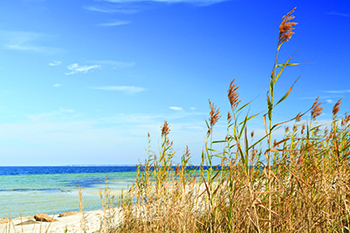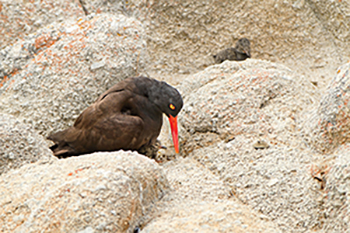
Audubon Adventures

Background for Teachers

Earth is a watery world, with nearly 70 percent of its surface covered in ocean, sea, river, and lake. The other 30% is covered in land. The shoreline is where these two geographic ingredients mix. There are hundreds of thousands of miles of coast on our planet. The United States alone has some 90,000 miles of seashore, not including lake and river frontage. This fragile ribbon of wildlife habitat between ocean and dune, sea and rock, lake and mud sustains tremendous biodiversity. Coastal habitats have complex food webs that include plants, animals, and nutrients from both water and land. The land and terrestrial wildlife are nourished by the nearby water and the water and aquatic wildlife get valuable resources from the land. Tides bring in plankton—small and microscopic aquatic plants and animals—and kelp that enter the food chain of terrestrial habitats, for example. The daily and seasonal changes in water levels also add niches of habitat for specially adapted plants and animals, such as tidepool dwellers. The graduation of fresh to salt water in marshes, mangrove swamps, and estuaries provides protected nurseries for sea life, and food for land life. This is why coasts and shorelines, lakefronts and riverbanks are such important ecosystems for birds, fish, turtles, and invertebrates of many kinds.
People like shores, too, and for good reasons. Coastlines protect human communities from storms and rising seas. Ports, docks, piers, wharfs, and harbors are busy transportation hubs for travelers and goods. Beaches around the world are popular places to play and live. Some people often view sandy beaches as sterile places that can be driven on, raked and graded, and built over. In reality, sandy beaches are important coastal habitat. Beaches provide nest sites for many birds and sea turtles, and are also feeding grounds for a variety of wildlife that come to take advantage of food coming in from the water. The water’s edge has also long been the dumping site for sewage and industrial waste, trash, and factory outflow. Environmental regulators often have an uphill battle against the misperception that the oceans are so vast that trash, pollution, and overfishing don’t take a toll. These human activities can have negative consequences for birds, wildlife, and the shoreline habitat they depend on and are adapted for.
Coastal Stewards Across America
Fortunately, many people value our coasts for the wildlife they sustain and want to peacefully coexist with the birds and other wild creatures there. There are many examples of successful ongoing coastal stewardship programs on all of the coasts of North America—Pacific, Gulf, and Atlantic. The “coastal wardens” of Audubon Texas are protecting 178 islands along their coast—a program that started more than eight decades ago. These islands are nesting sites for many waterbirds adapted to breeding in large colonies, like egrets, spoonbills, and pelicans. The wardens patrol the islands during nesting season and conduct a census of bird populations. They also work to improve the habitat the birds depend on by planting native shrubs and trees and controlling fire ants. Their efforts were crucial in helping Brown Pelicans come back from the brink of extinction. Brown Pelicans were unable to reproduce because of the pesticide DDT thinning their shells. DDT entered the food chain through water, concentrating in fish and the birds that ate them.
What Is a Shorebird?

Many different kinds of birds frequent shorelines. “Sharing Our Shores” focuses on the group that includes sandpipers, plovers, oystercatchers, stilts, godwits, avocets, and the like. Such groupings are usually more about where a bird lives than its taxonomic classification. You’ll find another such grouping in the Audubon Adventures topic titled “Seabirds: Feathered Ocean Mariners.” It also features birds frequently seen at the beach, but this group includes pelicans, skimmers, and terns, as well as puffins. With some exceptions, their life cycles include literally being “at sea” some of the time. In any case, the terms “shorebird” and “seabird” don’t always mean the same to everyone. And then there are the groups labeled “wading birds”—like herons and egrets—and “waterfowl”—such as ducks, geese, and swans.
While interesting to us, these bird-grouping names can make little sense to younger students and the distinctions among them are not that important for our purposes. These are all “waterbirds” united by a common need. All waterbirds are dependent on an aquatic habitat during some part of their lives. This inclusive “waterbird” definition serves Audubon’s focus on the conservation of native birds that breed, winter, or migrate across the North American continent. Developing a sense of curiosity and stewardship for birds and their habitats is what we hope young people will take away from “Sharing Our Shores.”
Stewardship programs run by Audubon chapters and volunteers along the Atlantic, Gulf, and Pacific coasts organize beach patrols when beach-nesting birds like plovers and terns are nesting. They rope off nest areas, install informational and warning signs created by local children, and educate the public about co-existing with the birds.
No amount of protection will save wildlife, however, if their habitat is toxic. Coastal projects by Audubon in the Long Island Sound and San Francisco Bay areas focus on cleaning up the vital estuary habitat by reducing pollution from sewage treatment plants, storm water runoff, and other sources. Protecting coastal areas and shoreline ecosystems takes efforts on both land and water.
The Extraordinary Birds of the Shores
Seabirds and shorebirds are fascinating and fun to watch. Terns hover over water and dive down on prey, Brown Pelicans plunge in with panache, and skimmers fly unbelievingly close to the sea surface. Flocks of plovers and sandpipers run, stop, and turn in unison on the sand, “sewing” for food. They perform elaborate mating displays and defend their nests and fluffy chicks with effective (and entertaining) ruses. Many shorebirds are amazing migrators, too. There are plovers that fly more than 2,000 miles nonstop from the Alaska to southern South America. Some godwits, Red Knots, and terns fly from the tip of South America to the Arctic Circle and back each year. Their long pointy wings carry them quickly and their bodies are adapted to turn food into fat to fuel the journey.
Like the habitats they depend on, coastal birds bridge water and land and require proficiency in both. Many of these birds are an intriguing combination of specialized adaptations and incredible versatility. They have unique bills and feeding adaptations to help them take advantage of specific prey, but also must be able to survive in varied habitats as they travel around the world. A single bird might breed on the Arctic tundra, spend the winter on a beach, and use mudflats and marshes during migration stopovers. It must be able to find food and avoid predators in all these places.
The dependency of coastal birds on clean water and land habitats in vastly different geographical regions makes them excellent indicator species—one that provides scientists with information about how it and other species in its food web and ecosystem are faring and what factors are at play. A decline in the breeding Red Knot population in the Arctic, for example, might be related to overfishing of horseshoe crabs at their stopover sites or beach development where they overwinter in South America.
Photos: Peggy Cook; ThinkStock; Bierchen/Adobe Stock




